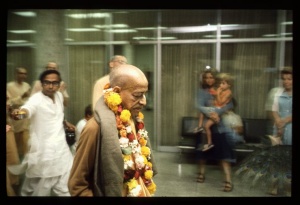CC Madhya 6.269 (1975)

A.C. Bhaktivedanta Swami Prabhupada
TEXT 269
- brahme, īśvare sāyujya dui ta' prakāra
- brahma-sāyujya haite īśvara-sāyujya dhikkāra
SYNONYMS
brahme—in the Brahman effulgence; īśvare—in the body of the Lord; sāyujya—merging; dui—two; ta'-indeed; prakāra—varieties; brahma-sāyujya—merging into the Brahman effulgence; haite—than; īśvara-sāyujya—merging into the body of the Lord; dhikkāra—more abominable.
TRANSLATION
Sārvabhauma Bhaṭṭācārya continued, "There are two kinds of sāyujya-mukti: merging into the Brahman effulgence and merging into the personal body of the Lord. Merging into the Lord's body is even more abominable than merging into His effulgence."
PURPORT
According to the opinion of the Māyāvādī Vedāntists, the living entity's ultimate success is to merge into the impersonal Brahman. The impersonal Brahman, or bodily effulgence of the Supreme Lord, is known as Brahmaloka or Siddhaloka. According to the Brahma-saṁhitā (5.40), yasya prabhā prabhavato jagad-aṇḍa-koṭi: the material universes are generated from the bodily rays of the Supreme Personality of Godhead. Yogīs who follow the principles of Patañjali accept the personality of the Absolute Truth, but they want to merge into the transcendental body of the Supreme Lord. That is their desire. Being the greatest authority, the Supreme Lord can easily allow many millions of living entities to merge into His body. The origin of everything is the Supreme Personality of Godhead, Bhagavān, and His bodily effulgence is known as the brahmajyoti, Brahmaloka or Siddhaloka. Thus Brahmaloka or Siddhaloka is a place where many sparklike living entities, parts and parcels of the Supreme Lord, are assembled. Because these living entities do not wish to keep their individual existences, they are combined and allowed to remain in Brahmaloka like so many atomic particles of sunshine emanating from the sun.
The word siddha is very significant. Siddha refers to one who has realized the Brahman effulgence and who has complete knowledge that the living entity is not a material atom but a spiritual spark. This understanding is described in the Bhagavad-gītā as brahma-bhūta. In the conditioned state, the living entity is known as jīva-bhūta, or "the living force within matter." Brahma-bhūta living entities are allowed to stay in Brahmaloka or Siddhaloka, but unfortunately they sometimes again fall into the material world because they are not engaged in devotional service. This is supported by Śrīmad-Bhāgavatam (10.2.32): ye 'nye 'ravindākṣa. These semi-liberated souls falsely claim to be liberated, but unless one engages in devotional service to the Lord, he is still materially contaminated. Therefore these living entities have been described as vimukta-māninaḥ, meaning that they falsely consider themselves liberated although their intelligence is not yet purified. Although these living entities undergo severe austerities to rise to the platform of Siddhaloka, they cannot remain there perpetually, for they are bereft of ānanda (bliss). Even though these living entities attain the brahma-bhūta stage and realize the Supreme Personality of Godhead through His bodily effulgence, they nonetheless fall down due to neglecting the Lord's service. They do not properly utilize whatever little knowledge they have of the Supreme Personality of Godhead. Not attaining ānanda, or bliss, they come down to the material world to enjoy. This is certainly a falldown for one who is actually liberated. The bhaktas consider such a falldown equal to achieving a place in hell.
The followers of the Patañjali yoga system actually want to merge into the body of the Supreme Personality of Godhead. This indicates that they do not want to engage in His service despite their knowledge of Him, and thus their position is even more abominable than that of those who want to merge into the Lord's effulgence. These yogīs meditate on the four-handed Viṣṇu form of the Lord in order to merge into His body. The Patañjali system describes the form of the Lord as kleśa-karma-vipākāśayair aparāmṛṣṭaḥ puruṣa-viśeṣa īśvaraḥ: "The Supreme Personality of Godhead is a person who does not partake of a miserable material life." The yogīs accept the eternity of the Supreme Person in one of their mantras-sa pūrveṣām api guruḥ kālānavac-chedāt: "Such a person is always supreme and is not influenced by the element of time." The followers of the Patañjali system therefore accept the eternity of the Supreme Personality of Godhead, yet, according to them: puruṣārtha-śūnyānāṁ pratiprasavaḥ kaivalyaṁ svarūpa-pratiṣṭhā vā citi-śaktir iti. They believe that in the perfectional stage, the conception of puruṣa is vanquished. According to their description: citi-śaktir iti. They believe that when one becomes perfect, he cannot remain a person. This yoga system is therefore abominable because its final conception is impersonal. In the beginning, these yogīs accept the Supreme Personality of Godhead, but they ultimately give up this idea in order to become impersonal. They are most unfortunate because although they have a personal conception of the Absolute Truth, they neglect to render devotional service to the Lord and thus fall down again into the material world. This is supported by Śrīmad-Bhāgavatam (10.2.32). Āruhya kṛcchreṇa paraṁ padaṁ tataḥ patanty adho 'nādṛta-yuṣmad-aṅghrayaḥ: due to neglecting the lotus feet of the Lord, these yogīs again fall down into the material existence (patanty adhaḥ). Consequently this path of yoga is more abominable than the impersonalists' path. This conclusion is also supported by Lord Kapiladeva in the following verse from Śrīmad-Bhāgavatam (3.29.13).